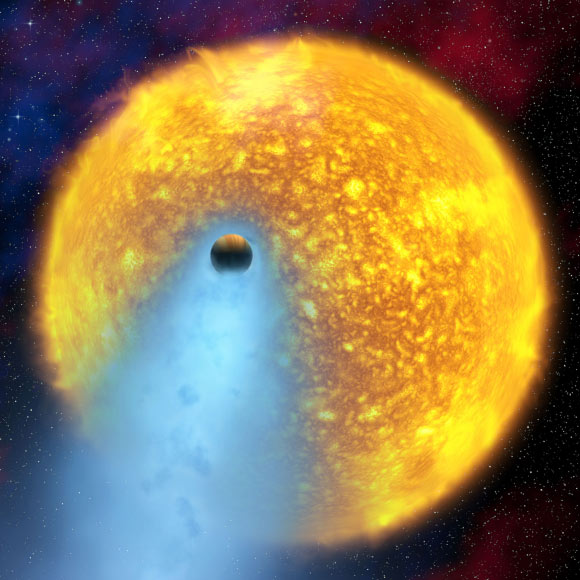A team of astrophysicists from Columbia University proposes that the strange long-term dimming of the KIC 8462852 star (also known as Tabby’s star or Boyajian’s star) is the result of a disk of debris — torn from a melting moon – that is accumulating and orbiting the star.

Artist’s illustration showing a massive exoplanet falling into its host star — one of the possible explanations for the strange dimming of KIC 8462852. Image credit: NASA / ESA / Alfred Vidal-Madjar, Institut d’Astrophysique de Paris, CNRS.
“The exomoon is like a comet of ice that is evaporating and spewing off these rocks into space,” said Dr. Brian Metzger, an astrophysicist in the Department of Physics and the Astrophysics Laboratory at Columbia University.
“Eventually the exomoon will completely evaporate, but it will take millions of years for the moon to be melted and consumed by the star. We’re so lucky to see this evaporation event happen.”
As an exoplanet is destroyed by strong interactions with its parent star, its moon can become vulnerable to the pull of the star.
The force can be so great that the star rips the exomoon away from its planet, causing the exomoon to either collide with a star or otherwise be ejected from the system.
In a small percentage of cases, however, the star steals the exomoon and places it into a new orbit around itself.
In this new orbit, the icy, dusty exomoon is exposed to radiation from the star that rips apart its outer layers, creating dust clouds that are eventually blown out to the planetary system.
When those clouds of dust pass between the star and Earth, intermittent dips in brightness are observed.
This explains the short-term, inconsistent dimming of KIC 8462852, but astrophysicists have had a harder time explaining the long-term overall fading.
“KIC 8462852 abducted an exomoon from a now long-gone, nearby planet and pulled it into orbit around itself, where it has been getting torn apart by stronger stellar radiation than existed in its former orbit,” the scientists said.
Chunks of the exomoon’s dusty outer layers of ice, gas, and carbonaceous rock have been able to withstand the radiation blow-out pressure that ejects smaller-grain dust clouds, and the volatile, large-grain material has inherited the exomoon’s new orbit around KIC 8462852, where it forms a disk that persistently blocks the star’s light.
The opaqueness of the disk can change slowly, as smaller-grain clouds pass through and larger particles stuck in orbit move from the disk toward KIC 8462852, eventually getting so hot that they melt and fall onto the star’s surface.
“Ultimately, after millions of years, the exomoon orbiting KIC 8462852 will completely evaporate,” the researchers said.
The findings were published in the Monthly Notices of the Royal Astronomical Society.
_____
Miguel Martinez et al. Orphaned Exomoons: Tidal Detachment and Evaporation Following an Exoplanet-Star Collision. MNRAS, published online September 5, 2019; doi: 10.1093/mnras/stz2464







